|
Shining
Light on Railroad Lanterns
By
Paul Koren
Of the various types of collectibles that
reflect the great age of American railroads, lanterns are among the most popular. They
remind people of an era when trains were run by steam power and when most facets of
personal and community life had some connection with the railroad. Over the last few
decades, a common approach to classifying railroad lanterns has gradually evolved among
collectors. The terms used here are sometimes quite different than that found in original
manufacturers' catalogs and railroad rule books. However, such terms serve the purpose of
allowing collectors to have a common understanding.
First, collectors usually make a
distinction between lanterns and lamps. A lantern is essentially a metal "cage"
containing a transparent or translucent globe that protects an interior light source. This
definition applies to lanterns using combustible fuel rather than electric lanterns, which
usually have exposed light bulbs instead of a globe.
Lamps are essentially a solid metal
cylinder with one or more lenses used to transmit light from an interior light source.
There are perhaps five basic categories that collectors use to classify railroad lanterns:
fixed-globe lanterns, tall-globe lanterns, short-globe lanterns, conductors' lanterns, and
inspectors' lanterns.
Conductors' Lanterns. A
style of lantern often used by conductors was the "conductors' lantern", also
called a "presentation lantern". The latter term reflects the fact that this
style of lantern was sometimes used for award purposes with markings honoring a specific
individual. As a category, conductors' lanterns were generally fancier and more finely
crafted than other lantern models. They are often found with nickel or brass plating,
ornate engravings, and/or globes with elaborate lettering. This difference in quality
reflected both the status of the conductor as the highest authority on a passenger train
(higher than the engineer), and the fact that his lantern was likely to be seen by the
traveling public.
A wide variety of conductors' lanterns were
produced by different manufacturers: Adams & Westlake, Meyrose, Post, Handlan-Buck,
C.T. Ham, and Parmalee & Nonnell.
One special globe often found in
conductors' lanterns is the two-color globe, so called because it consists of a band of
colored glass - usually green - over a band of clear glass. The purpose of the colored
glass was to shield the conductors' and passengers' eyes from glare while checking and
collecting tickets. Two-color globes are one of the "holy grails" of the hobby.
In today's market, they can go for hundreds, even thousands, of dollars.
Inspector's Lanterns.
Inspector's lanterns were characterized by a unique but utilitarian design suited to
examining rolling stock. They were typically constructed of sheet metal with a reflecting
surface made of metal or glass for focusing light in one direction. However, the flame was
enclosed in a globe, so they can reasonably be classified as a lantern. Inspector's
lanterns were produced in a couple of different sizes by only a few manufactures, among
them Dietz and Star Headlight & Lantern. Values usually range from $75 to $100 or so,
although examples with rare marked globes can be considerably lighter.
Fixed-Globe Lanterns. The
earliest type of railroad lantern was the fixed-globe lantern, so called because the globe
was cemented or plastered in a frame and could not be readily removed. This style of
lantern was most popular in the decades that spanned the Civil War. It's not possible to
precisely pinpoint the date when fixed-globe lanterns were replaced by the removable-globe
variety, although evidence suggests that the latter was introduced immediately after the
Civil War. However like most innovations, removable-globe lanterns were not instantly
adopted by the industry, and it appears that fixed-globe lanterns continued to be
manufactured for a decade or two after the Civil War.
The heyday of the fixed-globe lantern
especially coincided with the era of railroad expansion in the northeastern United States.
The first transcontinental railroad line was not completed until 1869; however, railroad
building in the northeast had already been underway for several decades. Therefore, most
of the railroad markings found on fixed-globe lanterns reflect lines from this part of the
country. There were many small manufacturers of railroad lanterns at the
time-standardization in the industry had yet to occur-so there is a wide variety of styles
and features that can be found in surviving fixed-globe lanterns.
All fixed-globe lanterns are rare. Values
generally range from $500 to $1,000 for examples with railroad markings, even higher for
examples with unusual historical provenance or rarity.
Tall-Globe Lanterns.
Tall-globe lanterns are distinguished by removable globes of 5 3/8" to 6" in
height. The fact that globes were both removable and interchangeable represented a real
improvement over fixed-globe models for obvious reasons of convenience. The first
removable-globe lantern was produced in 1865 by William Westlake. However, tall-globe
lanterns became the dominant style of railroad lantern during the period from the 1870s to
World War I.
Tall-globe lanterns are particularly
popular due to their variety of design and large number of railroad markings. Many
manufacturers produced such lanterns, including Adams & Westlake, Armspear,
Handlan-Buck, Dietz, Star Headlight & Lantern and C.T. Ham. Since tall-globe lanterns
were produced during the most expansive period of U.S. railroading, they often are marked
for railroads that are long gone and that have special historical significance. Since many
technological innovations occurred during this period, a variety of different models were
produced. Toward the end of tall-globe lantern production, the number of companies in the
industry narrowed down to a fairly small number, and a certain level of standardization
became the norm.
Market values of tall-globe lanterns vary
widely and depend on numerous factors, including the presence of a railroad marking, the
particular railroad represented, whether the globe is also marked for a railroad, whether
the globe marking is cast or etched, rarity of patent dates and so on.
At the lower end of the continuum, a
tall-globe lantern in good condition with both frame and globe marked for a common
railroad like the Pennsylvania Railroad might be acquired for around $100. The majority of
tall-globe lanterns fall in the $100 to $500 range. However, rare examples have been
setting new price records of late with some particularly rare globe and lantern
combinations going for thousands.
Short-Globe Lanterns.
Short-globe lanterns came into production after World War I and continued to be made for
specialty and commemorative purposes. Their regular use in railroad service effectively
ended in the late 1960s or early 1970s. They are generally characterized by standardized
globes that are 3 ?" in height, with the exception of a few models that take globes
up to 4 ?" in height. Short-globe lanterns succeeded tall-globe lanterns because
railroads switched to kerosene as lantern fuel after World War I, and the smaller burning
chamber of the shorter globe was especially suited to this type of fuel. The lighter
weight and better portability of the short-globe lantern were also positive factors in its
acceptance.
Among collectors, short-globe lanterns are
considered less desirable, mostly because as a class they are relatively newer and more
common. The major U.S. manufacturers were Adams & Westlake, Armspear, R.E. Dietz,
Lovell-Dressel, and Handlan. Dietz also made a series of lanterns called the
"Vesta", which used a special 4.25" globe that was an inch taller than a
true short globe. Despite this unique globe requirement, Vesta's were extremely popular
among railroads and are very common in today's market.
Market values of short-globe lanterns
reflect their more common status. This is a big advantage to the novice collector,
however, who can find them relatively easily and at reasonable prices. A short-globe
lantern in good condition with a marked frame but unmarked globe might be acquired for
around $50 to $60, sometimes even less. Of course those with rarer markings and cast
globes generally go for more-between $100 and $200.
About Globes. Much
reference has been made here to globes, and indeed, globes represent a special
sub-category of railroad lantern collecting. Marked globes - those marked with a railroad
name or initials - are particularly desirable, and colored globes (as opposed to those
with clear glass) are even more so. In railroad operations, globe colors had special
meaning: clear (and sometimes green) for proceed, red for stop, amber for caution, and
blue for "Rule 26", meaning equipment was being serviced and could not be moved.
In today's market, globe values are
generally determined by rarity of railroad markings and color. Clear globes are the most
common, followed by red, blue, green, and amber. It is not possible to specify globe
values without going into much detail. While an unmarked globe may be purchased for as
little as $15, an extremely rare globe recently achieved an auction price of over $25,000!
About Fakes and Reproductions.
As in other categories of antiques, reproductions and counterfeiting have begun to affect
the field of railroad lantern collecting. Reproduction globes have been made, reproduction
lantern frames have been imported from overseas, and some lantern markings have been added
or altered by unscrupulous individuals to increase value. While these problems have not
yet become an epidemic, they require increasing vigilance among collectors. The
Railroadiana Collector's Association, Inc. (see footnote) publishes information on
railroadiana fakes and counterfeiting in its magazine and on its website.
This overview only touches the surface of
railroad lantern lore. There is a lot more to be learned about this fascinating corner of
railroad history. Information on lanterns and other aspects of railroadiana can be found
on the website of Railroadiana Collectors Incorporated: http://www.railroadcollectors.org
.
The RCAI is dedicated to informing its
membership of all matters of railroad collectibles through its quarterly magazines and
website. To join, contact RCAI President Richard Wright at P.O. Box 4894, Diamond Bar, CA.
91765-0894 for an application. You may also get an application at the above web address.
Thanks to the collectors who supplied
photos for this article.
Sources:
Barrett, Richard C. The Illustrated Encyclopedia of Railroad Lighting: Volume One: The
Railroad Lantern (1994). Railroad Research Publications, Rochester, NY.
Knous, Bill and Sue. Railroadiana: The Official Price Guide for the Year 2000 and Beyond
(2000). RRM Publishing, Denver, CO.
01/2004
|
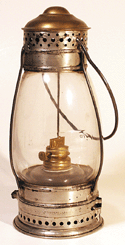
C.T. Ham fixed-globe
lantern with a brass top and clear globe marked "B&A RR" (Boston &
Albany Railroad).
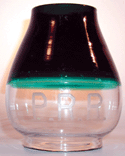
Pennsylvania R.R.,
2-color, tall globe with wheel-cut "PRR" initials.
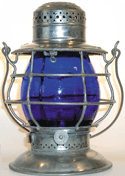
Dietz tall-globe
bellbottom lantern marked "B.A.&P." (Butte, Anaconda & Pacific Railway)
with a blue globe.
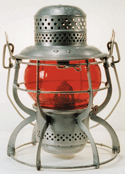
Armspear short-globe
lantern marked "B&O RR" (Baltimore & Ohio Railroad) with a red
globe."
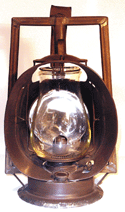
Dietz Acme
inspector's lantern marked "P&LE" (Pittsburgh & Lake Erie Railroad) with
a clear globe.
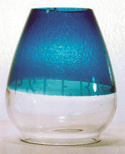
P & LE
(Pittsburg and Lake Erie RR), 2-color globe. |